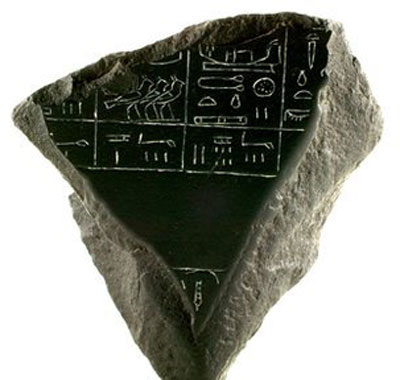New timeline for the beginning of ancient Egypt
British experts have discovered that the time to move from scattered land to becoming a nation of rulers in Egypt is faster than expected.
Using methods to identify carbon isotopes and computer models, they assumed that the first ruler of ancient Egyptian civilization came to power around 3100 BC, according to a report published by the Proceedings of the Royal Society A.

Palermo stone has the names of the first Egyptian kings - (Photo: Petrie Museum)
The team leader, Dr. Michael Dee of Oxford University, assessed the Egyptian formation as unique in the ancient world.
He said that ancient Egypt was a territorial country; a country formed from the established borders, very similar to the nations today.
So far, the first days of Egypt are based solely on rough estimates, since there are no written manuscripts in this period.
Until now, experts used isotopic analysis techniques to determine the age of hair, bones and plants, through archaeological evidence and models to give the best guess of the time Ancient formation.
Earlier records suggested that the pre-Dynasty period, when groups of people began settling along the Nile and exploiting land, occurred in 4000 BC.
But the new analysis shows that this period must start later, in mid-3700 or 3600 BC.
Only a few hundred years later, around 3100 BC, society transformed into an entity under the rule of the king, which was 300 or 400 years shorter than previously estimated.
Archaeologists believe that Egypt's first king, Aha, came to power after another influential leader, Narmer, unified the land.
The expert team could also arrange the reigning order of the subsequent seven kings and queens, including Djer, Djet, Merneith, Den, Anedjib, Semerkhet and Qa'a.
- Homosexuality in ancient Egypt
- Learn the disasters that destroyed ancient Egypt
- 6 things we do not know about the people of ancient Egypt
- 3 everyday items you won't believe are from ancient Egypt
- Mysterious mysteries of ancient Egypt
- Discovered an ancient tomb over 3,500 years old in Egypt
- Find ancient Pharaoh and god statues in Egypt
- Unexpected discovery of the
- The dangers you face if living in ancient Egypt
- Evidence of homosexual sex in ancient Egypt
- Discover the 3000-year-old fingerprint of ancient Egypt
- 1,700-year-old ancient school in Egypt
 Discovered an ancient centipede fossil 99 million years old
Discovered an ancient centipede fossil 99 million years old Discovered bat-like dinosaurs in China
Discovered bat-like dinosaurs in China Discovered a 200-year-old bronze cannon of the coast
Discovered a 200-year-old bronze cannon of the coast Discover 305 million-year-old spider fossils
Discover 305 million-year-old spider fossils